MARIANI’S
Virtual
Gourmet
September
13, 2020
NEWSLETTER
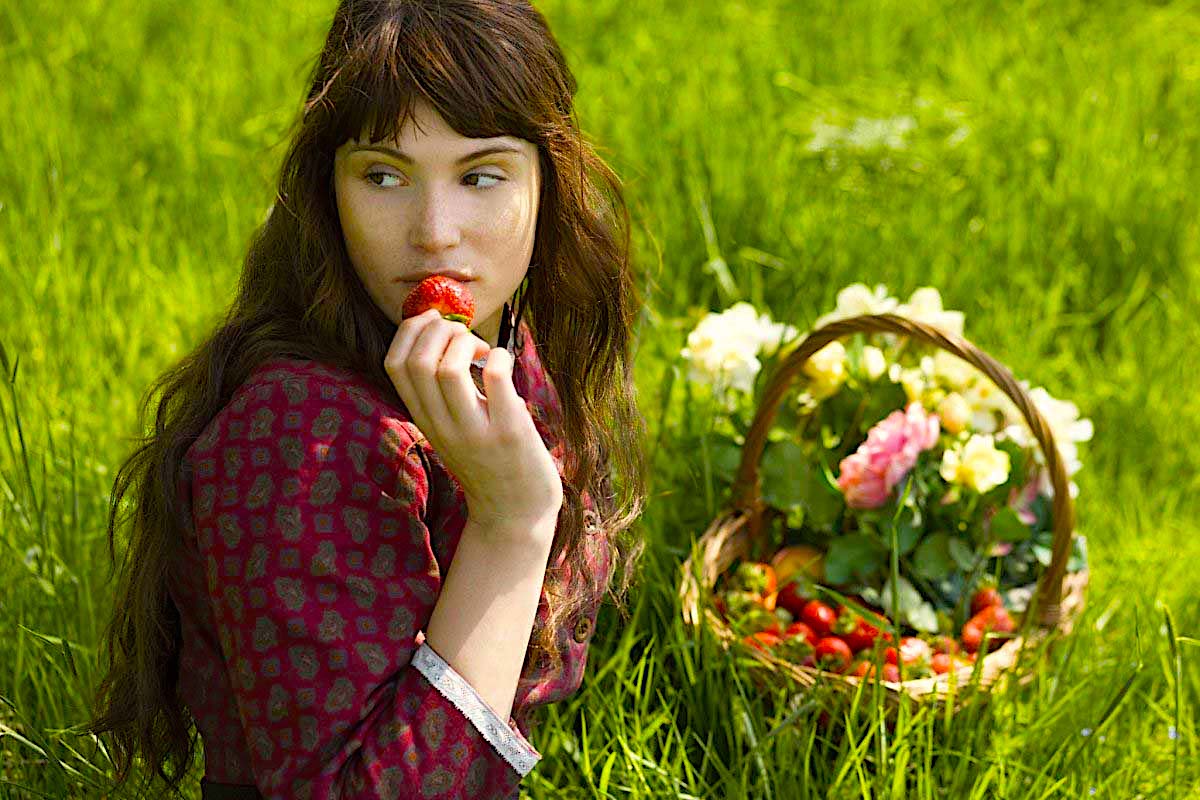
Gemma Arterton in "Tess of the D'Urbervilles" (2008)
❖❖❖
IN THIS ISSUE
Does a Chef Have
To Be Italian
To Cook Italian
Food Or Chinese to Cook Chinese
Food?
By John Mariani
MASTER HOUSTON
RESTAURATEUR
TONY VALLONE
DIES AT 75
By
John Mariani
LOVE AND PIZZA
CHAPTER TWENTY-FIVE
By John Mariani
NOTES FROM THE WINE CELLAR
SOME WINE BARGAINS
By Geoffery Kalish
◆◆◆
❖❖❖
Does a
Chef Have To Be Italian
To Cook
Italian Food Or Chinese
to Cook
Chinese Food?
By John Mariani
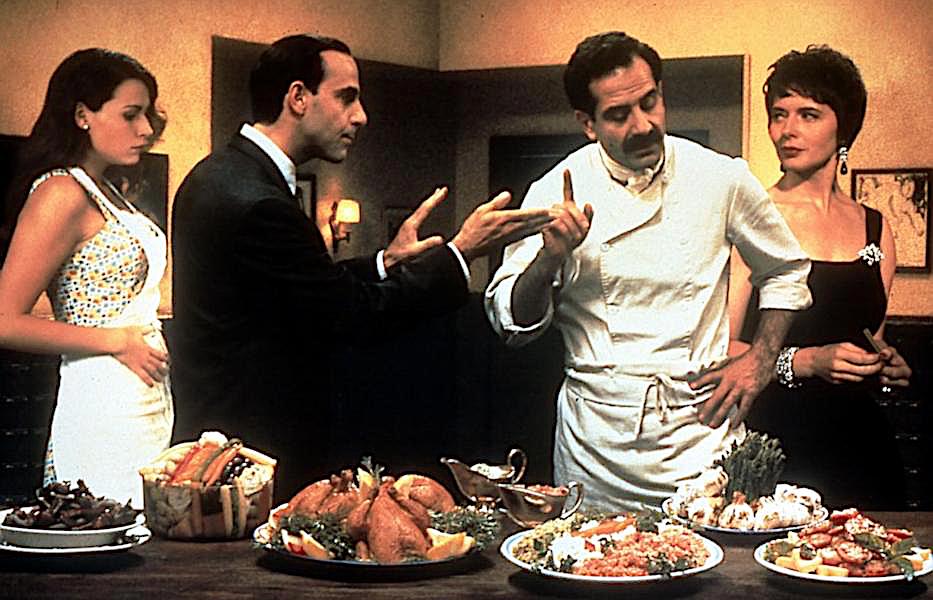
Minnie Driver, Stanley Tucci, Tony Shalhoub, Isabella Rossellini in "Big Night" (1996)
Take as long as you like to think about
it: How many of your favorite Chinese
restaurants have non-Chinese chefs at
the stoves? Or non-Thai chefs in
Thai restaurants? Or sushi bars run by American
chefs? But, how many Italian restaurants do you
know that have non-Italian chefs in the
kitchen? I’ll bet it’s plenty. And, of course,
there are plenty of American chefs cooking
French cuisine, perhaps trained at the Culinary
Institute of America or the French Culinary
Institute (now called the International Culinary
Center), whose courses, not without good reason,
focus on basic classic French technique.
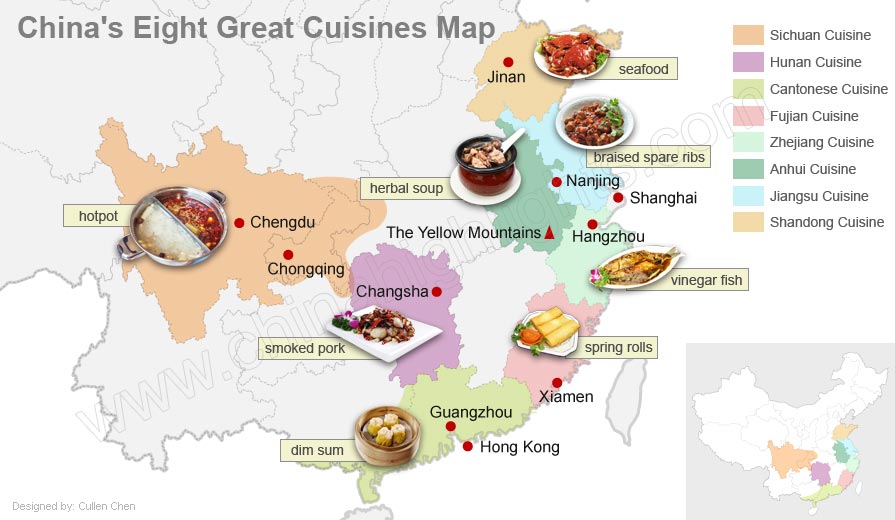 Two questions thereby
occur: First, does any chef have to be from the
country whose food he or she cooks? And, if there
are plenty of excellent French and Italian
restaurants in the U.S. run by non-Italians
or non-French
restaurateurs or chefs, is there anything to back
up an assertion that it would be much better if
they were?
Two questions thereby
occur: First, does any chef have to be from the
country whose food he or she cooks? And, if there
are plenty of excellent French and Italian
restaurants in the U.S. run by non-Italians
or non-French
restaurateurs or chefs, is there anything to back
up an assertion that it would be much better if
they were?
The fact, as noted, that so few Chinese,
Thai, Vietnamese, Korean, Philippino,
Japanese and Cambodian restaurants have anyone but
chefs and cooks from those nations in their
kitchens might suggest that there is a racial bias
against hiring non-Asians, though there’s no
evidence of that beyond the daunting prospect of
such a cook applying for a job where he or she has
not mastered cooking with a wok or bamboo steamer.
Who would hire a cook who was not already very
familiar with exotic ingredients of a kind rarely
found in western kitchens?
Instead, I think it’s a kind of pathetic
hubris that allows American cooks to think there
really isn’t much to making pizza, pasta or veal alla Milanese,
and to master a good French beurre blanc
or demi-glace.
To be sure—my wife and I wrote an entire
book entitled The
Italian-American Cookbook —many young cooks
who come from Italian-American backgrounds grew up
knowing the taste, texture, aroma 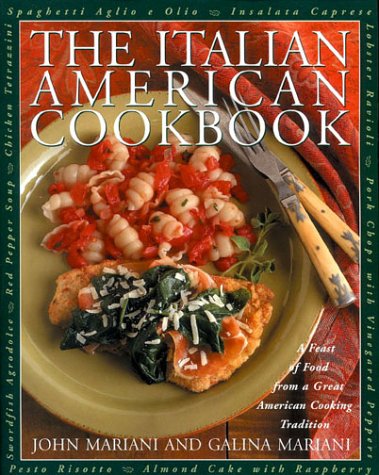 and seasonings of that off-shoot
of regional Italian food. And many of them, like
Paul Bartolotta, Alfred Portale, Mario Batali,
Marc Vetri and others, went to Italy to do the
real work of learning the rigors of true cucina
Italiana. As have many non-Italian-American
cooks,
like Michael White of Marea in New York, Christopher Gross of
Christopher's in Phoenix and Ken Vedrinksi of
Trattoria Lucca in Charleston.
and seasonings of that off-shoot
of regional Italian food. And many of them, like
Paul Bartolotta, Alfred Portale, Mario Batali,
Marc Vetri and others, went to Italy to do the
real work of learning the rigors of true cucina
Italiana. As have many non-Italian-American
cooks,
like Michael White of Marea in New York, Christopher Gross of
Christopher's in Phoenix and Ken Vedrinksi of
Trattoria Lucca in Charleston.
So,
too, in French restaurants around the U.S. you’ll
find well-trained non-French cooks who have done stages in
France, including Thomas Keller of Per Se in
New York and Julian Serrano of Picasso in Las
Vegas, and Alice Waters, who spent years in France
before opening Chez Panisse (below) in
Berkeley, Calif. It is not at all ironic that many
illustrious French chefs have learned a great deal
about Asian cooking by working abroad, not least 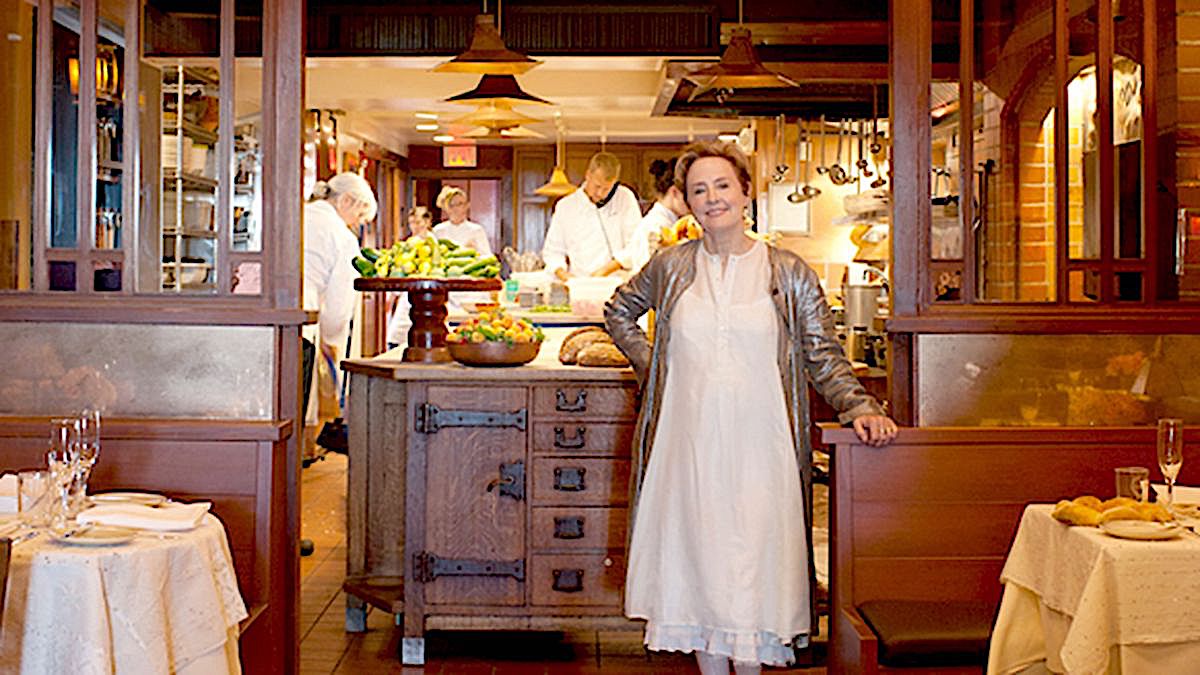 Jean-Georges
Vongerichten, who, in addition to his modern
French restaurant in New York, has also opened
Asian restaurants. He much preferred eating his
local staff’s food in the French restaurants he
ran in Hong Kong and Singapore. But when he hired
three Chinese chefs to man the kitchen at a
Chinese restaurant he opened in New York, they
left after three weeks and the restaurant closed
soon afterwards.
Jean-Georges
Vongerichten, who, in addition to his modern
French restaurant in New York, has also opened
Asian restaurants. He much preferred eating his
local staff’s food in the French restaurants he
ran in Hong Kong and Singapore. But when he hired
three Chinese chefs to man the kitchen at a
Chinese restaurant he opened in New York, they
left after three weeks and the restaurant closed
soon afterwards.
Forgetting for the moment why there
are so few Americans in Asian kitchens, it is open
for debate whether bloodlines or experience abroad
is all that necessary to produce good results. After
all, in so many restaurants in the U.S. the entire
kitchen staff might well be Mexicans or Latinos
from Central America. My own feelings on the
matter are, at the very least, that a little work
in the original fields couldn’t hurt to make a
cook better understand why a dish tastes the way
it does, where it comes from and why, and how the
right local ingredients make all the difference in
the world. 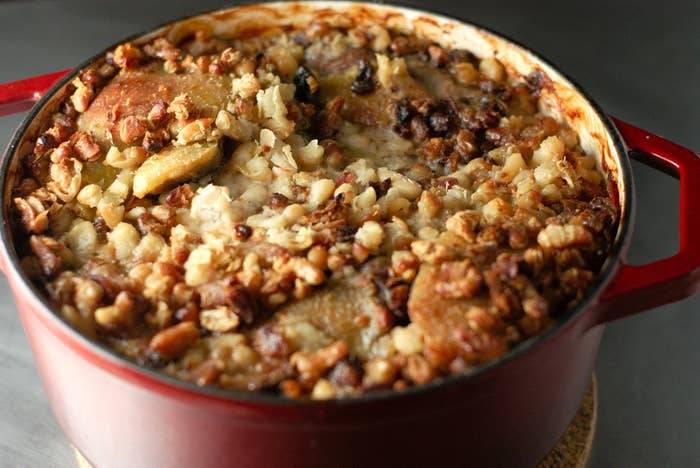
It’s the reason so many Americans come back
from abroad and groan, “Why can’t I get food that
tastes like I had in France/Spain/Italy/Portugal
back here in the U.S.?” Twenty years ago the
answer would be that American cooks had little
access to the same kind or quality of ingredients
that an Alsatian chef has to put into his
cassoulet (right); or a Venetian chef has
to make a fritto
misto of local seafood; or a Spanish chef
who has a choice of many great Iberian hams to
choose from; or an Indian chef whose market
carries 20 different kinds of chilies; or a Korean
chef whose options for kimchi
are endless. Tossing Sriacha or balsamic vinegar
or truffle oil on everything doesn’t do much for
the authentic taste of the original dishes you’d
have in Mumbai, Modena or Tuscany. Native born
chefs know that from long experience, just as
American barbecue cooks will argue endlessly about
the regional distinctions of their style, choice
of meat, smoking time and seasonings.
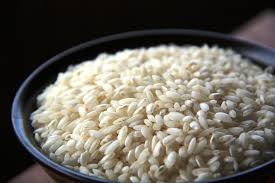 When TV cooks
tell viewers, “If you don’t have this or that
ingredient, just use whatever you do have,” it is
like telling the owner of a Maserati he can put
any kind of gas in the engine: It ain’t going to
work as well.
When TV cooks
tell viewers, “If you don’t have this or that
ingredient, just use whatever you do have,” it is
like telling the owner of a Maserati he can put
any kind of gas in the engine: It ain’t going to
work as well.
Today FedEx and DHL make the delivery of
many products readily available—even if the Dover
sole caught off the coast of Normandy on Thursday
doesn’t reach U.S. airports until Tuesday—but even
then it doesn’t mean a cook knows how best to
handle them. Having the finest Canaroli or Vialone
Nano rice (left) does not mean you know how
to make a first-rate risotto. One of my sons, who
once cooked at the restaurant Marea in New York,
was taught to make risotto by an Italian woman who
would only impart her secrets to him and only him.
(He’s never even told me what
they are.) These things take a long time of
practice, even among master chefs.
André Soltner (right), now retired,
was chef-owner of New York’s illustrious Lutèce
for thirty years, and he once served me a dish
he’d been trying to perfect for all that time and
finally came close enough to serve it, telling me
how his compatriot, the great Roger Vergé, came to
Lutèce one night, tasted the same dish and
exclaimed, “André, I’ve been trying to make that
damn dish for thirty years! How did you do it?”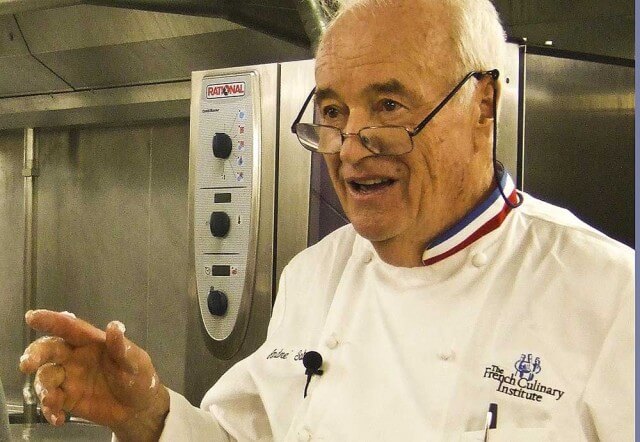
To be fair, I’ve had some wonderful French
and Italian food prepared by cooks whose
nationality could be Martian, though I’ve rarely
had first-rate Asian food via non-Asian
chefs, with one exception—OKO in Westport, Conn.,
where chef-owner Brian Lewis is doing great sushi
and Japanese food. I do know that when French or
Italian chefs open restaurants in China or Japan,
they have been astonished at how quickly the cooks
master a technique and how clinically they prepare
the mise
en place. But they also say that it is
cooking by rote, not an understanding of what the
dish is or where it comes from.
As in most
things in life, a little learning is a dangerous
thing in the kitchen, especially among those young
chefs who try to assimilate centuries of culinary
tradition of many different nations into their
trendy menus. Thirty years may be too long for a
chef to perfect a dish, but a few attempts with a
recipe and an ego is worth next to nothing.
❖❖❖
MASTER HOUSTON
RESTAURATEUR
TONY VALLONE DIES AT
75
By John Mariani
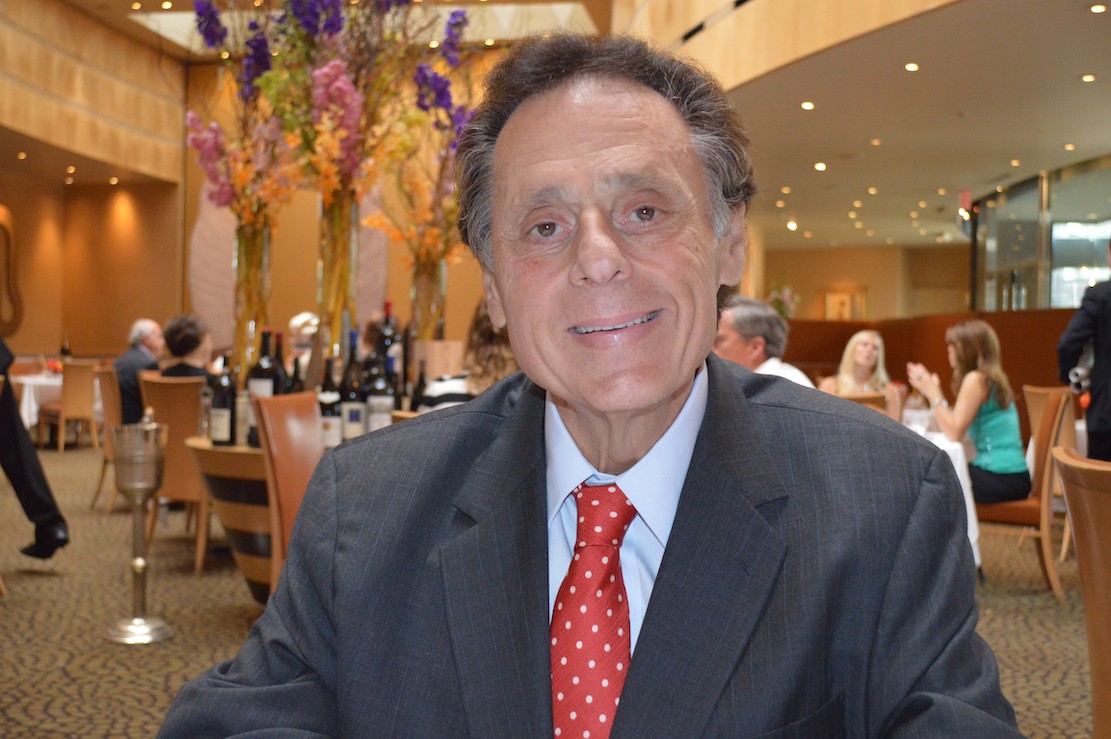
Chefs
and
restaurateurs often say that you have to deeply
love cooking and serving people to survive the
rigors of their chosen profession, and for any
restaurant to survive past the ten-year mark is
a remarkable achievement. So, for one man to
keep his restaurant at the top of its form for
55 years is nothing short of astonishing. But
this is what Tony Vallone, owner of Tony’s in
Houston, achieved and he did it all with that
grace under pressure few could maintain in a
world of fashion, trends, economic downturns,
even pandemics. He passed away this week at the
age of 75.
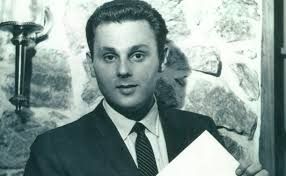 Tony was many
things, not least a Houstonian (more so than a
Texan) and an Italian-American, whose love for
both heritages was borne out by his never opening
branch restaurants around the U.S. and by annually
visiting Italy with members of his staff, all
expenses paid, to see what the Italian chefs were
doing and how they maintained
such longevity in their restaurants.
Tony was many
things, not least a Houstonian (more so than a
Texan) and an Italian-American, whose love for
both heritages was borne out by his never opening
branch restaurants around the U.S. and by annually
visiting Italy with members of his staff, all
expenses paid, to see what the Italian chefs were
doing and how they maintained
such longevity in their restaurants.
When only 20 years old, Tony took over a
tiny eatery from his father, with whom he’d had a
troubled relationship, and saw immediately that
Italian restaurants in America could be better
than their red sauce-and-Chianti image and the
caricature of an Italian host who was expected to
look and act like the fat, mustachio-ed Tony in
Disney’s Lady
and the Tramp animated feature. By the late
1970s he had transformed Tony’s into one of
Houston’s finest restaurants of any kind, although
it was more in the prevailing “continental
cuisine” mold than Italian. The walls were red
brocade, gilt covered many surfaces and the entire
staff wore tuxedos.
Tony cultivated Houston’s society crowd at
a time when Texas had considerable political and
celebrity clout, in addition to sports teams that
soon brought the world to Tony’s.
Luciano Pavarotti (right) stood up
and sang in the middle of the dining room. Sophia
Loren ordered take-out to her hotel, which Tony,
shaking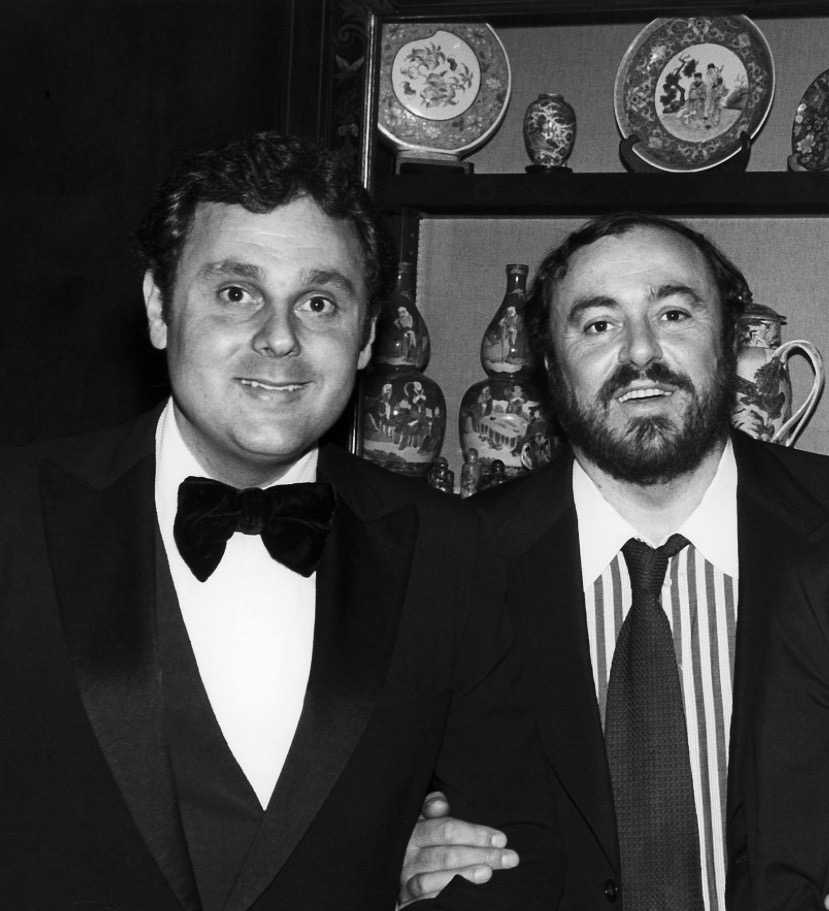 all the way over, personally
delivered. Not just the Bushes but other
presidents dined there, knowing how much exposure
it provided. And, amidst a menu of chateaubriand
and flaming desserts, Tony always kept a pot of
his famous chili on the stove for his Texan
friends.
all the way over, personally
delivered. Not just the Bushes but other
presidents dined there, knowing how much exposure
it provided. And, amidst a menu of chateaubriand
and flaming desserts, Tony always kept a pot of
his famous chili on the stove for his Texan
friends.
Tony came to admire the mastery of his
field as exhibited with extraordinary suave by
Sirio Maccioni, owner of New York’s Le Cirque,
who, with his tall, dark, handsome looks and
Tuscan savoir-faire, was the physical opposite of
Tony, who for his whole life battled his
considerable weight. But Tony could match Maccioni
in elegant bonhomie—with a little Texas swagger—as
well as his grand gestures, like sending the
restaurant’s cuisine to regular guests in the
hospital. Indeed, it might be said that Tony’s was
not the Texas version of Le Cirque but that Le
Cirque was the New York version of Tony’s.
In the 1990s Tony’s was
reconfigured as a larger new space that epitomized
Houston big-hair glamor and high taste with a
modern décor and contemporary artwork that was a
good fit for the best architecture of the moment.
The menu, by then, had shifted largely to Italian
cuisine, with an emphasis on Italian wines in a
cellar that ranked with the finest in America. He
would FedEx in whatever the seasons brought from
all over, not least Italian seafood, cheeses and
white truffles.
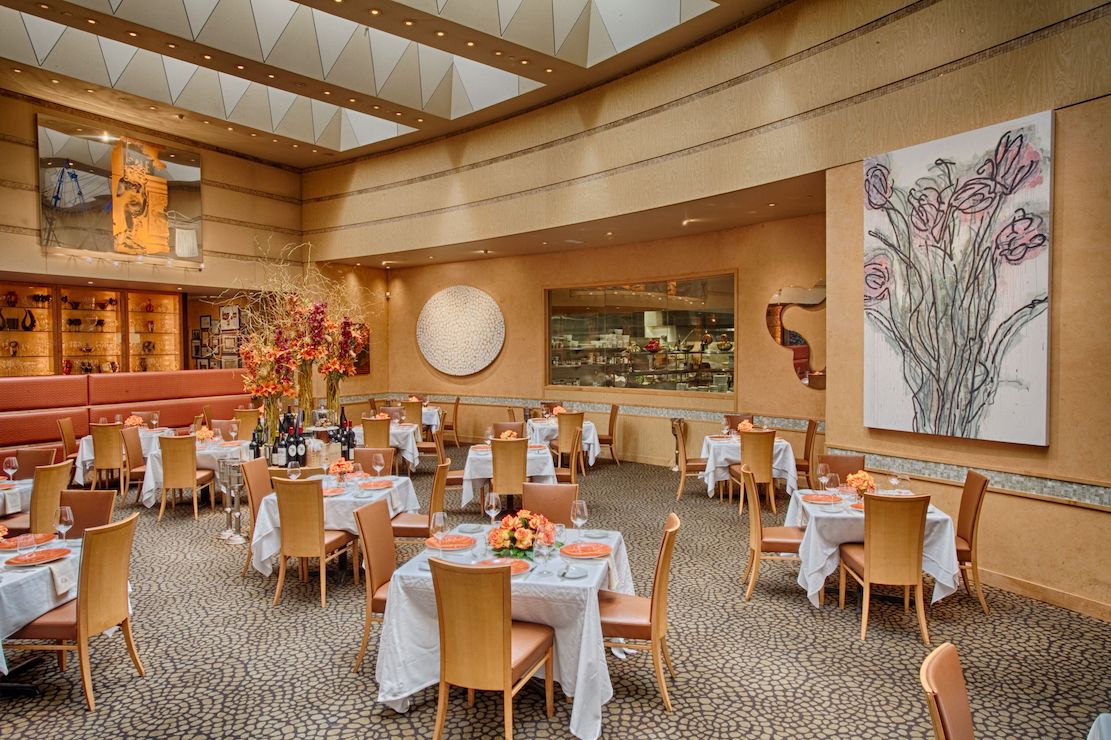 Tony
was obviously a taskmaster in a rough industry,
but in public and with his clientele, he was
always very sweet, very gentlemanly and extremely
discreet in a dining room where men with women not
their wives might show up with regularity. He had
to deal with Texas-sized egos, whether they were
billionaire oil men, tech tycoons or Houston
Astros not used to the finer things in life.
Tony
was obviously a taskmaster in a rough industry,
but in public and with his clientele, he was
always very sweet, very gentlemanly and extremely
discreet in a dining room where men with women not
their wives might show up with regularity. He had
to deal with Texas-sized egos, whether they were
billionaire oil men, tech tycoons or Houston
Astros not used to the finer things in life.
At his side and behind him there was his
marvelous wife, Donna, whose own down-to-earth
spirit made everyone who met her relax within the
swirl of Tony’s dining room. She also tended to
Tony over the past couple of decades with various
medical problems, not least his see-saw weight
losses and gains. Sadly, the Vallones also lost
one of their sons this past summer, which was a
crushing blow.
I came to know Tony very well by the 1980s
and I was 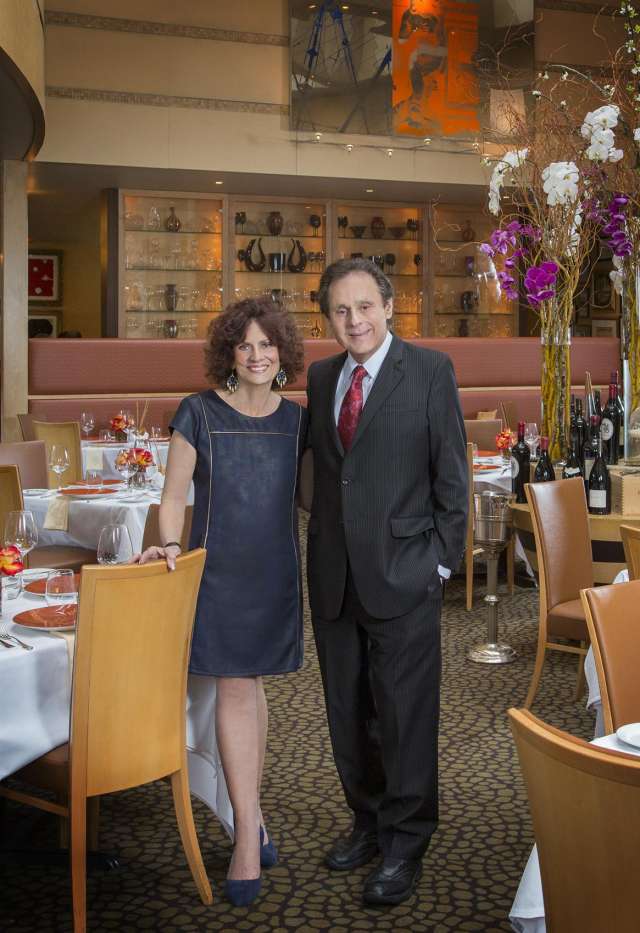 in total
admiration of his character, his kindness and his
resiliency. He even asked me to co-author his
autobiography after an earlier attempt fizzled,
and we were supposed to meet for several
interviews over a six-month period. But Tony, ever
busy with work and new ideas, could never find the
time to sit down with me. I still have my notes
from the time we did have some time together,
about his early years, his fear of being thought
of as just a spaghetti-slinger and how those first
years were so tough in initiating even the
slightest changes that might put off his dinner
guests.
in total
admiration of his character, his kindness and his
resiliency. He even asked me to co-author his
autobiography after an earlier attempt fizzled,
and we were supposed to meet for several
interviews over a six-month period. But Tony, ever
busy with work and new ideas, could never find the
time to sit down with me. I still have my notes
from the time we did have some time together,
about his early years, his fear of being thought
of as just a spaghetti-slinger and how those first
years were so tough in initiating even the
slightest changes that might put off his dinner
guests.
I wanted so much to go on with the story
and into those years when he and his restaurant
came to such glory, widely recognized as one of
the very best restaurants in America, and Tony
himself was considered to rank with the country’s
most legendary restaurateurs, like Dave Chasen of Chasen's,
Lester Gruber of the Detroit Chop House in
Detroit, Vince Bommarito of Tony’s in St. Louis,
Lee Comisar of Maisonette in Cincinnati,
Ernest Byfield of the Pump Room Chicago, Victor
and Roland Gotti of Ernie’s San Francisco, Piero
Selvaggio of Valentino in Los Angeles and, yes,
Sirio Maccioni, who admired Tony immensely.
Donna
(right) has said she will carry on Tony’s
legacy at the restaurant, and, knowing how
professional and how devoted his staff has always
been, I hope that will be the case. Tony’s without
Tony will not be Tony’s as it was. Indeed, there
could never be another like it. But I hope it
endures and thrives. America needs the kind of
inspiration Tony Vallone gave us all.
❖❖❖
By John Mariani
LOVE AND PIZZA
Since, for the time being, I am unable to write about or review New York City restaurants, I have decided instead to print a serialized version of my (unpublished) novel Love and Pizza, which takes place in New York and Italy and involves a young, beautiful Bronx woman named Nicola Santini from an Italian family impassioned about food. As the story goes on, Nicola, who is a student at Columbia University, struggles to maintain her roots while seeing a future that could lead her far from them—a future that involves a career and a love affair that would change her life forever. So, while New York’s restaurants remain closed, I will run a chapter of the Love and Pizza each week until the crisis is over. Afterwards I shall be offering the entire book digitally. I hope you like the idea and even more that you will love Nicola, her family and her friends. I’d love to know what you think. Contact me at loveandpizza123@gmail.com
—John Mariani
To read previous chapters go to archive (beginning with March 29, 2020, issue.
LOVE AND PIZZA
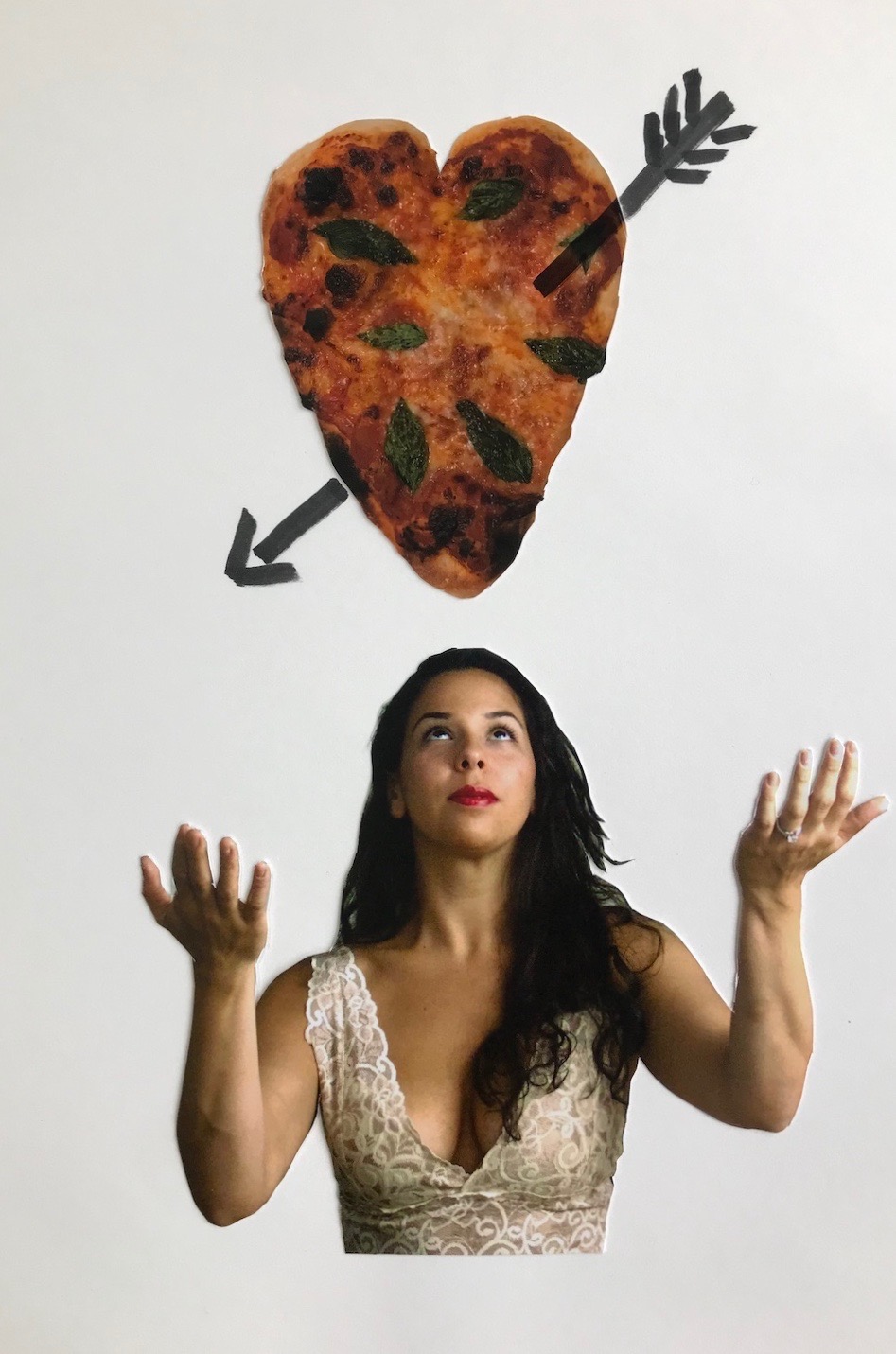
Cover Art By Galina Dargery
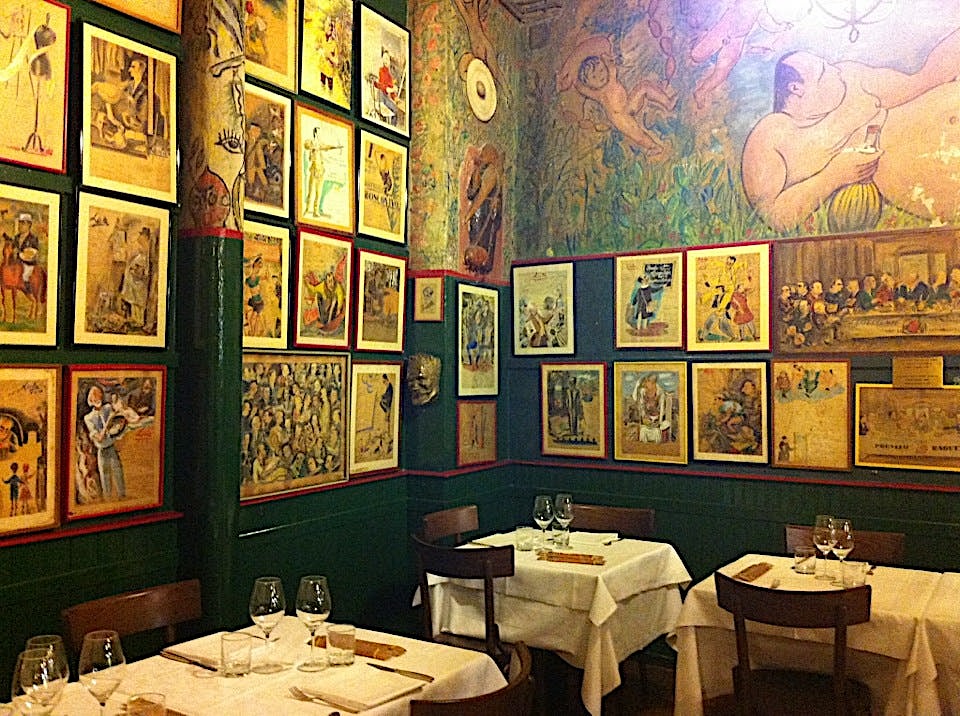 The day before leaving for the States,
Nicola received another call from the International
Herald-Tribune writer, whose name was
Hermione Schlosser,
asking if this was a better time for Nicola to
do an interview.
The day before leaving for the States,
Nicola received another call from the International
Herald-Tribune writer, whose name was
Hermione Schlosser,
asking if this was a better time for Nicola to
do an interview.
Bagutta
“Well,
I’m leaving for New York tomorrow,” said Nicola,
feeling pressured. “How long would this take?”
“Whatever you can give me. Half-hour,
hour?”
Nicola looked at her watch and said, “Okay,
if you can come here—I’m still packing—I’d be
happy to do the interview.”
One hour later, the very odd-looking Ms.
Schlosser arrived at Nicola’s dorm. She was
perhaps sixty, five-foot-two and a tilt past 150
pounds. She
sported a short henna bob, wore a moo moo in a
black-and-white Op Art design, thick round glasses
in the style of Le Corbusier, and what
appeared to be gold-tasseled ballet slippers.
Nicola expected her demeanor to match her
look, but instead Hermione Schlosser was a very
down-to-earth reporter who, after asking each
question, nodded and kept murmuring “mm-hmm” till
the answer was finished. She wrote in an eccentric
shorthand that made Nicola wondered if it was
shorthand at all.
“So,” began Hermione, “Let me get this
straight: Patrizia Palma—I love her
work, don’t you? So underrated—saw you at Le
Langhe and—"
“Actually it was at Bagutta,” said Nicola.
“Okay, Bagutta. Wherever. So she
spots you and leaps across the room and cries out,
`You
will be the next big thing in Milan!"
“Not exactly. She said I looked like
Claudia Cardinale and that a model she was using
the next day had to drop out and asked me if I
would go on the runway.”
“Well, I’m sure your head just must have
... popped!”
said Hermione, splaying her fingers from the sides
of her head.
“Patrizia always acts on the spur of the
moment. Gets
her in trouble sometimes. So you
agree, and then what?”
“Well, first I told her I’d never modeled.”
“That wouldn't matter to Patrizia.”
Nicola went on to describe the next 24
hours, adding to what Hermione already knew and
correcting what she thought she knew. “Well,
whatever happened, “ said Hermione, “you’ve caused
quite a stir. It’s like”—blocking headlines in the
air—`UNKNOWN AMERICAN GIRL TAKES MILAN FASHION
WEEK BY STORM!’”
Nicola winced a little at that and said, “I
think that’s overstating the case a little.”
“Honey, the only reason I’m here is because
everybody’s still talking about you. You have been
unofficially christened `The New Girl,’ and you
are doubly, triply interesting because you seemed
to have vanished since then.”
Nicola explained that, with Fashion Week
over, there really wasn’t any other immediate
venue for her to model, even if she wanted to,
although she had gotten phone calls to sign with
an agency and to model in the future in Milan.
“So what’s the back story?” asked Hermione.
“The back story?”
“Your background. Where are you from. America,
obviously, and New York, I can tell. What
else?”
“I was born and bred in the Bronx,” began
Nicola.
“Duh
Bronx,” repeated Hermione with a thick New Yawk
accent. “That’s a good angle: girl from New York’s
poorest, most dangerous borough rises to the cream
of the crop in Milan.”
“Ms. Schlosser,” said Nicola, yet again
trying to hold herself back from blasting away at
such ignorance, “The Bronx is a really big
borough, and while it’s got the same problems as
the other boroughs, there are parts of it, like
where I live, that are neither poverty stricken
nor dangerous.”
“Where’s that, honey?” asked Hermione,
scribbling furiously.
Nicola went into a brief, almost curt,
description of Belmont, and said she hoped the
reporter would accept what she was told about the
neighborhood.
“Got it,” said Hermione. “So what else
about you?”
Nicola finished the interview playing up
her academic credentials and insisted that she was
going on to grad school.
“So, no more modeling?”
“I’m not sure at this point.”
“Girl like you can make a lot of money. You
hit the cover of an Italian fashion magazine, or
model for one of the big designers, you’ll get
noticed in the States, where the big money is.”
“Well, all that is definitely not part of
my current thinking. I’ll just have to see what
happens. I
am going back to the U.S. tomorrow to do a shoot
with a new magazine.”
“Willi,
right? I
heard.”
Nicola was amazed at all Hermione had
apparently heard about her, almost wanting to ask
the reporter’s advice but realizing it was  already
past the hour she’d agreed to for the interview.
already
past the hour she’d agreed to for the interview.
Hermione was gracious, thanked Nicola for
her time, told her the article would appear the
next day in the Trib,
and, upon heading for the door, said, “Honey, I
don’t think this is the last I’ll hear about you. I think
you’ve really got what it takes, if you’re willing
to take it on. Okay, gotta go. Gotta go write this
thing.”
Nicola laughed when
Hermione strode off to hail a taxi, hoping the old
girl would write something Nicola would want her
family to read.
Then she finished packing, sat down on the
bed and stared out the window at the drizzle that
seemed yet again to hold springtime at bay. She
watched as a small van stopped in front of the
dorm’s entrance and a man got out with a bouquet
of flowers. A
few seconds later her bell rang and she let the
man in, meeting him at the landing.
“Signorina
Santini?
Prego.”
Nicola brought the bouquet of spring
flowers into her room and, sure they were from
Giancarlo, gleefully tore open the little
envelope. The
note read, “Have a good flight! Can’t wait to work
together this week! Best, Elena Duran.”
Nicola was impressed by her new
benefactor’s graciousness, but, although it didn’t
occur to her until that moment she received the
flowers, she now wondered why Giancarlo had not
sent her a going-away bouquet.
That night her dorm friends took her out
for dinner at Bagutta—where more than a few heads
turned when she walked in--and wished her luck,
demanding to be informed of all the details of her
coming visit to New York.
“I have your phone number,” warned
Catherine, “You will be
getting calls.”
Then Nicola remembered that she still had
never gotten Giancarlo’s phone number nor did he
have hers back in the States. “Well,”
she thought, “I’ll be back in a week anyway. No time
for either of us to expect a letter.”
The next morning, when Nicola arrived at
Malpensa airport (above) and went through
security, she found the day’s edition of the International
Herald Tribune displayed at the newsstand.
She bought  a copy and
riffled the pages until she came to the fashion
report, with a story headlined, “Girl from `Duh
Bronx’ Takes Milan Fashion World by Storm” by
Hermione Schlosser.
a copy and
riffled the pages until she came to the fashion
report, with a story headlined, “Girl from `Duh
Bronx’ Takes Milan Fashion World by Storm” by
Hermione Schlosser.
“Shit!” said Nicola. “The bitch.” But when
she read the story the ridiculous headline gave
way to a very balanced report on Nicola, with no
need of corrections, that was more about how the
city’s fashionistas were ever in search of “The
New Girl” and seem to have found her to be a
beautiful, unassuming, perhaps reluctant American
girl who “had her head on straight.”
Nicola told herself, “This I
can show to my family.”
The announcement came for her
flight and Nicola boarded, asking which was the
First Class cabin.
She was cordially seated by a pretty
stewardess in a sky blue Pan Am suit, who asked if
she’d like some Champagne before taking off. Nicola
sat back in the roomy seat—no one sat next to
her—sipped her wine and felt she was, at least for
the moment, living in a charmed bubble, like those
breaking to the surface of the Champagne.
BARGAIN
BOTTLES TO MATE
WITH
FALL & WINTER FARE
By
Geoffrey Kalish
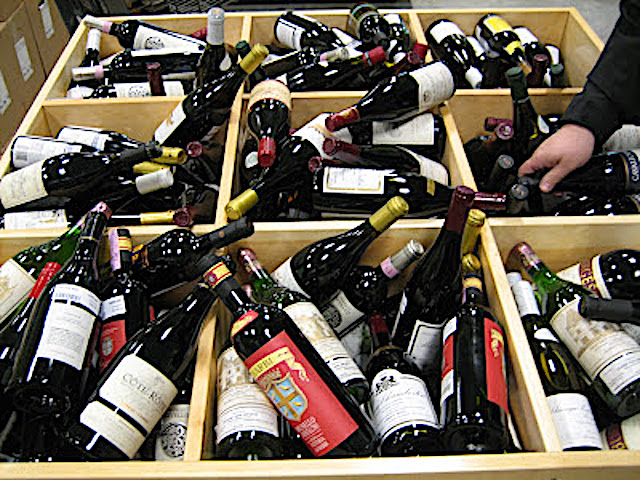
What makes a bottle of wine a
bargain? Yes, it’s locating bottles you like
at less than normal price or buying 6 or 12
bottles at a shop and getting a markedly
reduced overall cost, often from a bargain bin
box. But, there’s other bargains, like finding
reasonably priced bottles that far exceed the
expectations of the usual quality of that type
of wine or the wine from a particular area,
for example Beaujolais or Chablis. Or finding
top-quality products at a good price (say
under $30 a bottle) from little known areas or
from areas not in the current mainstream of
popularity (like Fixin in Burgundy). However,
no matter what the price, if you don’t enjoy
the wine it’s never a bargain. So, based on
tastings over the past year, here are some of
my selections (by category) that “fill the
bill” as bargains and great mates for hearty
fare.
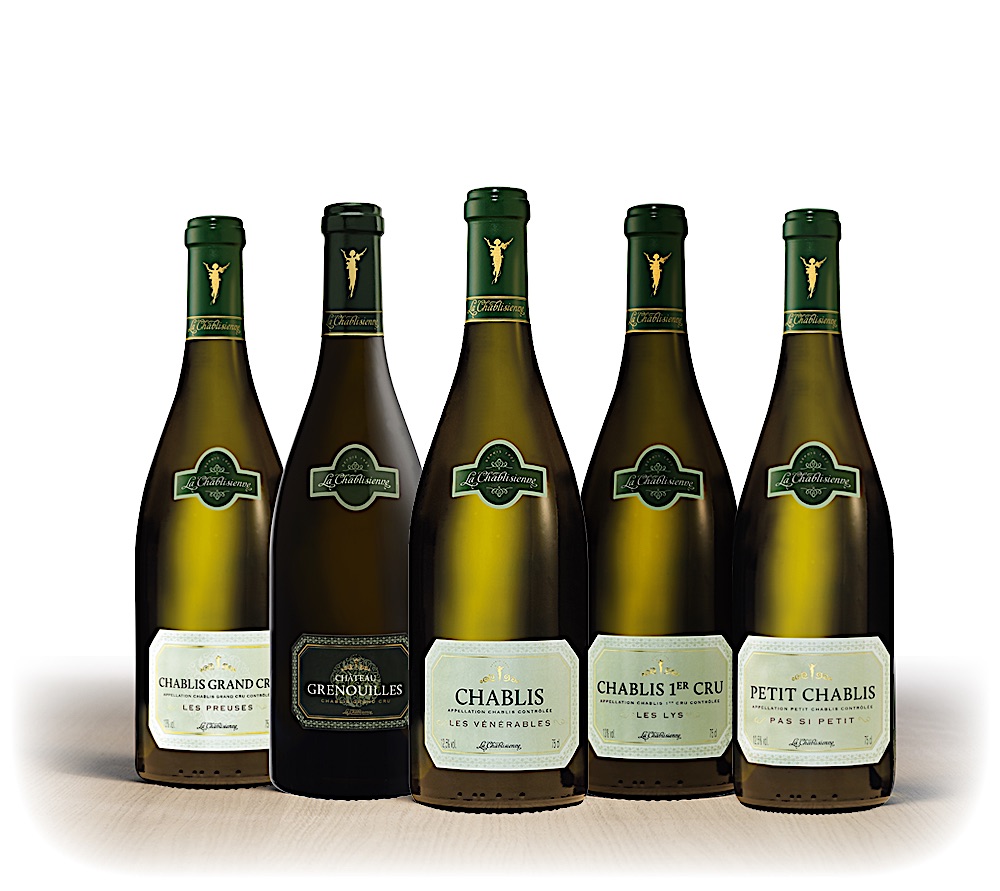 CRISP
CHABLIS
CRISP
CHABLIS
2016 La Chablisienne
Chablis La Pierrelée ($27)
2015 Louise Dubois
Chablis ($25)
Located about halfway
between Paris and Beaune, the Chablis region is
noted for unique soils containing clay and
limestone as well as ocean fossils, giving most
of the wines produced in the area a distinctive
crispness in their finish in addition to their
ripe apple and lemony bouquet and taste. These
two wines have that crispness and both mate well
with appetizers like smoked salmon and olive
tapenade on toast as well as with main course
items like grilled swordfish or pasta with
cheese sauces. What makes these two wines
bargains is that they drink like much more
expensive Premier and Grand Cru selections from
the same region.
RACY
RIESLINGS
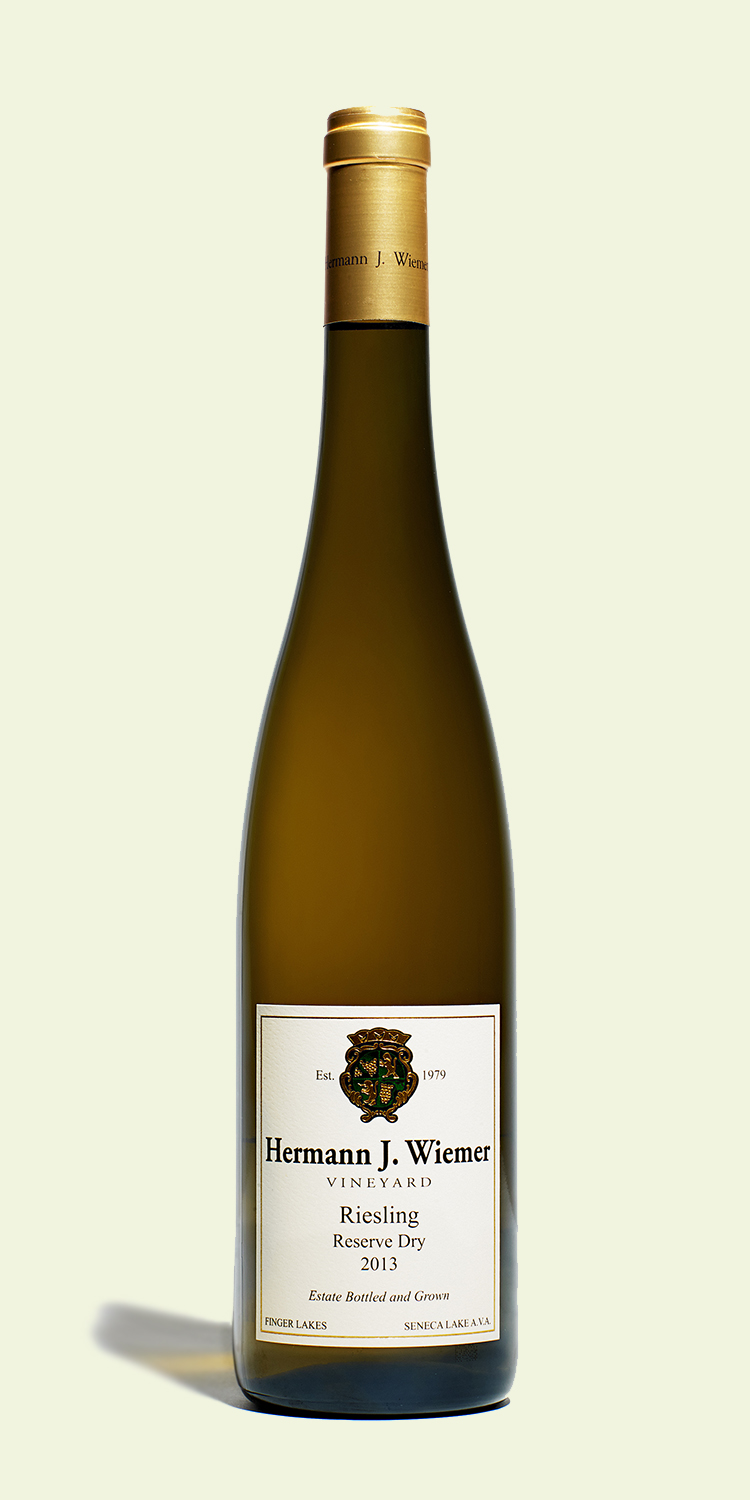 2018 Forge Cellars
Dry Riesling ($17)
2018 Forge Cellars
Dry Riesling ($17)
2016 Hermann J.
Wiemer Dry Riesling ($21)
KOSHER
CABERNET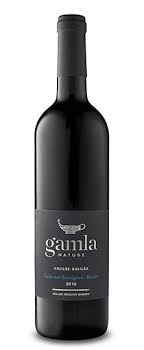
2016 Gamlal Cabernet
Sauvignon ($19)
2016 Segal’s Fusion
($17)
The Gamlal is an
easy-drinking oak-aged wine, made primarily of
Cabernet Sauvignon and some Merlot and Cabernet
Franc from the Golan Heights and Upper Galilee
It offers a well integrated bouquet and taste of
cherries, plums and cassis. Additionally,
it’s meshuval
(important for Orthodox Jews), meaning it can be
handled and served by non-Jews. And, hailing
from Israel’s Galilee Heights, the Segal Fusion
is not technically a Cabernet (it contains 60%
Merlot, 20% Cabernet Sauvignon and 20% Cabernet
Franc), yet it tastes more like one than a
typical Merlot, showing dry, long-lasting
flavors of cassis and blackberries and a bit of
tannin in its finish.
 BERRY-RICH
BROUILLY & BURGUNDY
BERRY-RICH
BROUILLY & BURGUNDY
2018 Nicole Chanrion
Domaine de la Vouté des Crozes
Côte-de-Brouilly ($20)
2016 Robert Perroud L’Enfer des
Ballouquets Brouilly ($17)
2011 Albert Bichot
Fixin ($24)
2016 Lucien Muzard & Fils
Vielles Vignes Santenay ($34)
While neither of these Brouillys
made of Gamay grapes from southern Beaujolais
are on the tip of even the tongues of the wine
cognoscenti, they both offer great value in bold
full-flavored wines that show bouquets and
tastes of ripe cherries and raspberries with
hints of spice in their finish. Pair either with
casseroles, charcuterie or pasta with meat
sauces.
The other two
Burgundies (a bit aged but still available in
the marketplace) are great choices for those
that enjoy the fragrant bouquet and smooth,
elegant plummy, cranberry taste of good Burgundy
but are unwilling to pay the upwards of $100 a
bottle now being asked for many bottles of this
quality from this now prized region of France.
They both make perfect accompaniment for duck,
seared tuna, rack of lamb or veal.
Sponsored by

Any of John Mariani's books below may be ordered from amazon.com.
 The Hound in Heaven
(21st Century Lion Books) is a novella, and
for anyone who loves dogs, Christmas, romance,
inspiration, even the supernatural, I hope you'll find
this to be a treasured favorite. The story
concerns how, after a New England teacher, his wife and
their two daughters adopt a stray puppy found in their
barn in northern Maine, their lives seem full of promise.
But when tragedy strikes, their wonderful dog Lazarus and
the spirit of Christmas are the only things that may bring
his master back from the edge of despair.
The Hound in Heaven
(21st Century Lion Books) is a novella, and
for anyone who loves dogs, Christmas, romance,
inspiration, even the supernatural, I hope you'll find
this to be a treasured favorite. The story
concerns how, after a New England teacher, his wife and
their two daughters adopt a stray puppy found in their
barn in northern Maine, their lives seem full of promise.
But when tragedy strikes, their wonderful dog Lazarus and
the spirit of Christmas are the only things that may bring
his master back from the edge of despair. WATCH THE VIDEO!
“What a huge surprise turn this story took! I was completely stunned! I truly enjoyed this book and its message.” – Actress Ali MacGraw
“He had me at Page One. The amount of heart, human insight, soul searching, and deft literary strength that John Mariani pours into this airtight novella is vertigo-inducing. Perhaps ‘wow’ would be the best comment.” – James Dalessandro, author of Bohemian Heart and 1906.
“John Mariani’s Hound in Heaven starts with a well-painted portrayal of an American family, along with the requisite dog. A surprise event flips the action of the novel and captures us for a voyage leading to a hopeful and heart-warming message. A page turning, one sitting read, it’s the perfect antidote for the winter and promotion of holiday celebration.” – Ann Pearlman, author of The Christmas Cookie Club and A Gift for my Sister.
“John Mariani’s concise, achingly beautiful novella pulls a literary rabbit out of a hat – a mash-up of the cosmic and the intimate, the tragic and the heart-warming – a Christmas tale for all ages, and all faiths. Read it to your children, read it to yourself… but read it. Early and often. Highly recommended.” – Jay Bonansinga, New York Times bestselling author of Pinkerton’s War, The Sinking of The Eastland, and The Walking Dead: The Road To Woodbury.
“Amazing things happen when you open your heart to an animal. The Hound in Heaven delivers a powerful story of healing that is forged in the spiritual relationship between a man and his best friend. The book brings a message of hope that can enrich our images of family, love, and loss.” – Dr. Barbara Royal, author of The Royal Treatment.
 |
The Encyclopedia of American Food and Drink by John F. Mariani (Bloomsbury USA, $35) Modesty forbids me to praise my own new book, but let me proudly say that it is an extensive revision of the 4th edition that appeared more than a decade ago, before locavores, molecular cuisine, modernist cuisine, the Food Network and so much more, now included. Word origins have been completely updated, as have per capita consumption and production stats. Most important, for the first time since publication in the 1980s, the book includes more than 100 biographies of Americans who have changed the way we cook, eat and drink -- from Fannie Farmer and Julia Child to Robert Mondavi and Thomas Keller. "This book is amazing! It has entries for everything from `abalone' to `zwieback,' plus more than 500 recipes for classic American dishes and drinks."--Devra First, The Boston Globe. "Much needed in any kitchen library."--Bon Appetit. |
"Eating Italian will never be the same after reading John Mariani's entertaining and savory gastronomical history of the cuisine of Italy and how it won over appetites worldwide. . . . This book is such a tasteful narrative that it will literally make you hungry for Italian food and arouse your appetite for gastronomical history."--Don Oldenburg, USA Today. "Italian
restaurants--some good, some glitzy--far
outnumber their French rivals. Many of
these establishments are zestfully described
in How Italian Food Conquered the World, an
entertaining and fact-filled chronicle by
food-and-wine correspondent John F.
Mariani."--Aram Bakshian Jr., Wall Street
Journal.
"Equal parts
history, sociology, gastronomy, and just
plain fun, How Italian Food Conquered the
World tells the captivating and delicious
story of the (let's face it) everybody's
favorite cuisine with clarity, verve and
more than one surprise."--Colman Andrews,
editorial director of The Daily
Meal.com. "A fantastic and fascinating
read, covering everything from the influence
of Venice's spice trade to the impact of
Italian immigrants in America and the
evolution of alta cucina. This book will
serve as a terrific resource to anyone
interested in the real story of Italian
food."--Mary Ann Esposito, host of PBS-TV's
Ciao
Italia. "John Mariani has written the
definitive history of how Italians won their
way into our hearts, minds, and
stomachs. It's a story of pleasure over
pomp and taste over technique."--Danny Meyer,
owner of NYC restaurants Union Square
Cafe, The Modern, and Maialino.
|
 |
 |
 |
 |
 |
 |
 |
 |
 Everett Potter's Travel Report:
Everett Potter's Travel Report: 
 Eating Las
Vegas JOHN CURTAS has been covering
the Las Vegas food and restaurant scene
since 1995. He is the co-author of EATING LAS
VEGAS – The 50 Essential Restaurants (as
well as the author of the Eating Las
Vegas web site: www.eatinglasvegas.
He can also be seen every Friday morning as
the “resident foodie” for Wake Up With the
Wagners on KSNV TV (NBC) Channel 3 in
Las Vegas.
Eating Las
Vegas JOHN CURTAS has been covering
the Las Vegas food and restaurant scene
since 1995. He is the co-author of EATING LAS
VEGAS – The 50 Essential Restaurants (as
well as the author of the Eating Las
Vegas web site: www.eatinglasvegas.
He can also be seen every Friday morning as
the “resident foodie” for Wake Up With the
Wagners on KSNV TV (NBC) Channel 3 in
Las Vegas.
MARIANI'S VIRTUAL GOURMET
NEWSLETTER is published weekly. Publisher: John Mariani. Editor: Walter Bagley. Contributing Writers: Christopher Mariani,
Robert Mariani, Misha Mariani, John A. Curtas, Gerry Dawes, Geoff Kalish,
and Brian Freedman. Contributing
Photographer: Galina Dargery. Technical
Advisor: Gerry
McLoughlin.
If you wish to subscribe to this
newsletter, please click here: http://www.johnmariani.com/subscribe/index.html
© copyright John Mariani 2020

